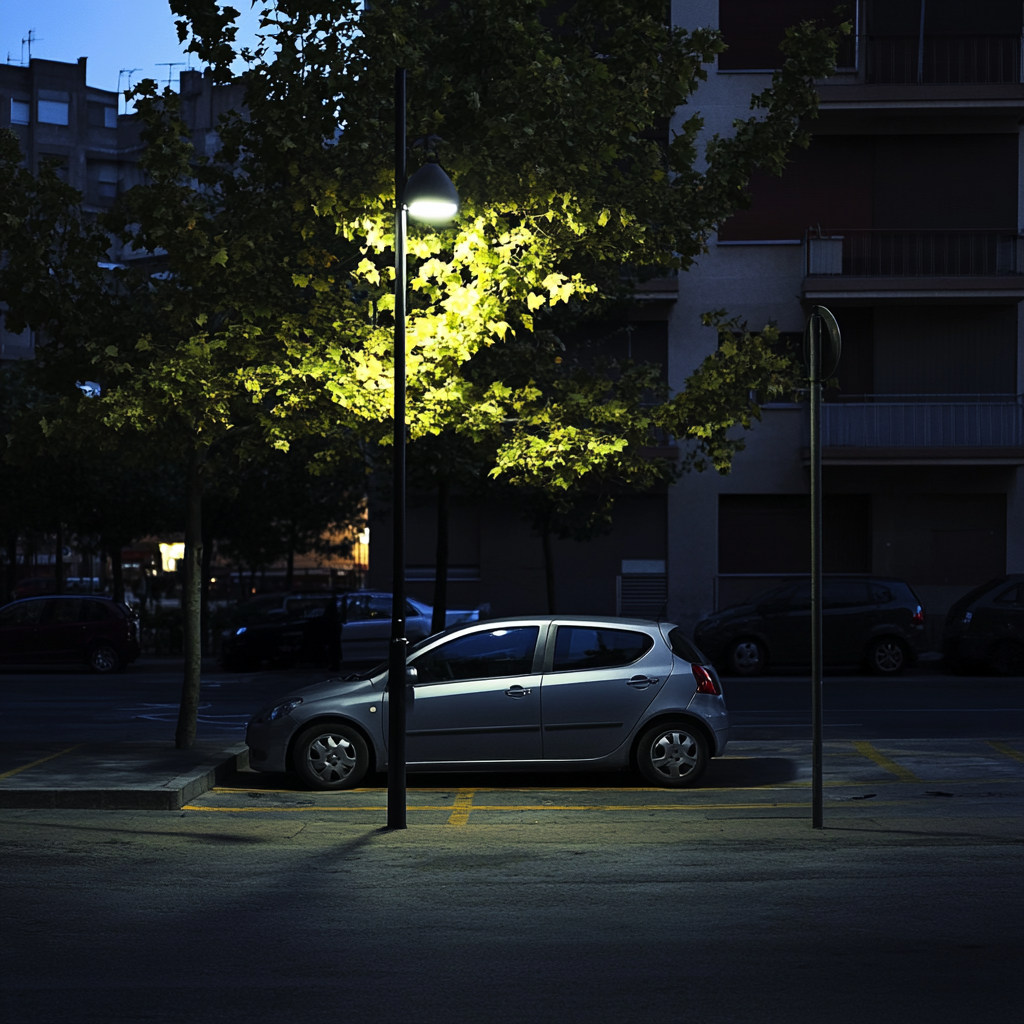
In the heart of Lower Manhattan, an unusual 29-story skyscraper, devoid of windows, stands tall and mysterious. Its code name is Titanpointe, and it is located at 33 Thomas Street. This building has baffled New Yorkers for years.
The building, constructed in 1974, was designed to withstand atomic blasts and was initially intended to house vital telecommunications equipment. It was envisioned as a communication nerve center, fortified against nuclear threats, by the architectural firm John Carl Warnecke & Associates.
This imposing structure, a gray tower of concrete and granite soaring 550 feet into the New York skyline, remains, unlike any other building in its vicinity. Unlike neighboring residential and office buildings, it does not have a single window and remains unilluminated. At night, it takes on an eerie presence, and by day it casts a giant shadow, its square vents emitting a faint hum, often drowned out by the city’s bustling sounds.
For decades, 33 Thomas Street, also nicknamed the “Long Lines Building,” has captured the imagination of New Yorkers as one of the city’s weirdest and most iconic skyscrapers. But the true purpose of this enigmatic structure has remained largely concealed, shrouded in secrecy.
The Secret Behind 33 Thomas Street
Beyond its enigmatic exterior, 33 Thomas Street conceals a deeper secret. This building appears to be more than just a telecommunications hub. Evidence from documents obtained by NSA whistleblower Edward Snowden, along with architectural plans and interviews with former AT&T employees, suggests that 33 Thomas Street served as an NSA surveillance site, code-named Titanpointe.
The NSA’s involvement goes beyond mere speculation. Inside the building, there’s a major international gateway switch that routes phone calls between the U.S. and countries worldwide. The NSA is believed to have tapped into these calls from a secure facility within the AT&T building. This covert surveillance program has targeted not only international organizations like the United Nations, the International Monetary Fund, and the World Bank but also numerous countries, including U.S. allies.
While AT&T has cooperated with the NSA on surveillance, few details have emerged about the specific role of facilities like 33 Thomas Street in carrying out top-secret programs. The Snowden documents, however, provide unprecedented insight into how NSA equipment has been integrated into AT&T’s network in New York City. This integration reveals the methods and technology employed by the agency to gather communications data from the company’s systems.
The NSA’s presence within this iconic skyscraper raises questions about the boundaries of surveillance in the modern world. As Elizabeth Goitein, co-director of the liberty and national security program at the Brennan Center for Justice, points out, “This is yet more proof that our communications service providers have become, whether willingly or unwillingly, an arm of the surveillance state.” The deep integration of the NSA within domestic communications infrastructure challenges the notion that such surveillance can be neatly confined to non-American targets.
Após uma ligação de um estranho, a história de amor recente de uma mulher se transforma em um drama – História do dia

“Todos os homens são mentirosos.” Com essas palavras, Violet encerrou seu programa de rádio. Suas experiências de vida e as inúmeras histórias que ouviu de seus ouvintes provaram isso. Mas, um encontro com um colega de trabalho a fez questionar sua crença. Após uma ligação de um estranho, ela se convenceu de que estava certa o tempo todo.
Violet sentou-se confortavelmente em sua cadeira, inclinando-se ligeiramente em direção ao microfone no estúdio aconchegante e mal iluminado de uma estação de rádio local.
O zumbido suave do equipamento e o leve zumbido das luzes do painel de controle lançavam um brilho quente e dourado pela sala.
Em frente a ela estava James, seu co-apresentador, com uma postura mais relaxada, os dedos batendo ritmicamente na mesa enquanto ouviam a voz crepitando pelos alto-falantes.

Apenas para fins ilustrativos. | Fonte: Midjourney
“Ele está se afastando de mim…” A voz de Susan tremeu, e um soluço abafado saiu.
“Não sei o que fazer. Nós mal conversamos mais. Nunca pensei que recorreria a um programa de rádio para pedir conselhos, mas não tenho mais ninguém que ouça.”
Violet ajustou seus fones de ouvido e sua expressão se suavizou.
“Não se preocupe, Suzy, certo? Esse é seu nome?”
Sua voz era calma, como o ritmo constante de um batimento cardíaco, oferecendo conforto em meio à estática.

Apenas para fins ilustrativos. | Fonte: Midjourney
“Sim, é Susan”, confirmou a pessoa que ligou, com a respiração entrecortada.
“Bem, Suzy, é por isso que temos este segmento — para ajudar pessoas como você com dificuldades de relacionamento. Obrigada por compartilhar sua história. É corajoso da sua parte.”
Susan hesitou antes de perguntar: “Então… o que você acha que eu deveria fazer, Violet?”
Violet se endireitou na cadeira, seu tom era áspero, mas controlado.
“A mesma coisa que eu sempre digo — esqueça-o. Ele está te traindo ou te enrolando. De qualquer forma, você merece algo melhor.”

Apenas para fins ilustrativos. | Fonte: Midjourney
James levantou a cabeça de repente e levantou uma sobrancelha para ela.
“Violet, talvez não devêssemos tirar conclusões precipitadas. Pode ser qualquer coisa — estresse no trabalho, problemas pessoais. Talvez ele não saiba se comunicar.”
Violet lançou-lhe um olhar de soslaio.
“Ou talvez ele tenha uma amante,” ela disse secamente. “Não vamos adoçar a pílula. Todos os homens são mentirosos.”
A tensão pairou por um momento, mas Violet rapidamente se voltou para o microfone, com seu sorriso profissional firme no rosto.

Apenas para fins ilustrativos. | Fonte: Midjourney
“Obrigada por sintonizar, pessoal. Aproveitem a próxima música.” Ela apertou o botão, desligando os microfones.
A música encheu o estúdio, e Violet se recostou, com um leve sorriso nos lábios.
James, no entanto, balançou a cabeça levemente, sem saber se deveria recuar ou deixar passar.
As luzes do estúdio diminuíram um pouco quando o silêncio do fim do turno caiu sobre a sala.
Violet juntou suas coisas: seu caderno, fones de ouvido e um cachecol grande que ela colocou sobre o ombro.
Ela se movia com sua eficiência habitual, mas sua mente já estava no conforto do lar e em uma xícara de chá quente.

Apenas para fins ilustrativos. | Fonte: Midjourney
James permaneceu perto do console, transferindo o peso do corpo de um pé para o outro.
Seu comportamento descontraído usual parecia ausente, substituído por um nervosismo perceptível. Finalmente, ele se aproximou, limpando a garganta.
“Você foi implacável com os homens hoje, como sempre”, ele disse, lançando-lhe um sorriso tímido. Sua tentativa de humor foi recebida com uma sobrancelha levantada.
Violet fez uma pausa e olhou para ele.

Apenas para fins ilustrativos. | Fonte: Midjourney
“Você está aqui há seis meses, James”, ela respondeu categoricamente. “Achei que você já tivesse descoberto o que nosso público espera.”
“Então é só para audiência?” James perguntou, inclinando a cabeça.
“Você realmente não acredita em tudo isso?”
Violet deu de ombros, sua expressão era ilegível.
“Eu nunca disse isso. O que você quer, James? Eu estava prestes a ir para casa.”

Apenas para fins ilustrativos. | Fonte: Midjourney
James esfregou a nuca, olhando para qualquer lugar, menos para ela. “Bem, uh… Eu estava querendo perguntar…” Suas palavras sumiram enquanto sua confiança vacilava.
“Desembucha”, Violet disse, sorrindo levemente, divertida com a estranheza dele. “Falar é suposto ser o seu trabalho.”
Ele riu nervosamente, seu rosto corando. “Você, hum… gostaria de ir a um encontro comigo?”
“Um encontro?” Violet piscou, pega de surpresa. “Tipo um encontro-encontro?”
“Sim. Exatamente. Há um ótimo lugar aqui perto que acho que você gostaria.”

Apenas para fins ilustrativos. | Fonte: Midjourney
Violet hesitou, mudando a bolsa de lugar no ombro. “James, você sabe que eu não sou muito fã de encontros.”
“Porque você acha que todos os homens são mentirosos, certo?” James provocou. Seu tom era leve, mas ousado. “Deixe-me provar que nem todos nós somos tão ruins. Alguns de nós são, em sua maioria, honestos.”
“Na maioria?”, Violet repetiu, rindo apesar de si mesma. “Bem. Mas não espere milagres.”
“Isso é bom o suficiente para mim”, disse James, seu sorriso aumentando enquanto ele pegava seu casaco.
O pequeno restaurante parecia uma joia escondida, o tipo de lugar que você nunca encontraria a menos que alguém lhe mostrasse.

Apenas para fins ilustrativos. | Fonte: Midjourney
A luz de velas tremeluzia em todas as mesas, lançando tons quentes e dourados pelo ambiente enquanto as notas suaves do jazz ao vivo pairavam no ar.
Os músicos, escondidos em um canto, tocavam como se fizessem parte do coração da sala, e suas melodias suaves faziam o espaço parecer vivo e relaxante.
James puxou uma cadeira para Violet, seus movimentos naturais, sem força. Violet levantou uma sobrancelha, mas não conseguiu evitar um pequeno sorriso enquanto se sentava.

Apenas para fins ilustrativos. | Fonte: Midjourney
“A cavalaria não morreu, pelo que vejo”, ela brincou.
“Bem, eu tento”, disse James com um sorriso, sentando-se em frente a ela.
Violet olhou ao redor, observando o ambiente aconchegante.
“Este lugar é encantador”, ela admitiu. “Eu não sabia que lugares como este ainda existiam.”
“A julgar pela sua expressão, você não costuma ir a lugares como esse”, disse James, inclinando-se ligeiramente para a frente, com um tom brincalhão.

Apenas para fins ilustrativos. | Fonte: Midjourney
“Eu não saio com frequência para encontros, isso é certo”, respondeu Violet, alisando o guardanapo no colo.
“Sério? Difícil de acreditar. Uma apresentadora de rádio e uma beleza dessas? Você deve ter admiradores.”
As bochechas de Violet ficaram rosadas e ela acenou para ele ir embora.
“Pare com isso. Eu costumava namorar, mas desisti há muito tempo. Sempre pareceu uma perda de tempo.”
James inclinou a cabeça, curiosidade brilhando em seus olhos. “Por que isso?”
Violet hesitou antes de responder.

Apenas para fins ilustrativos. | Fonte: Midjourney
“Depois de lidar com traição, mentiras e ouvir todas essas histórias no programa… É difícil acreditar no amor hoje em dia.”
A expressão de James se suavizou.
“Bem”, ele disse gentilmente, “nem todos nós somos tão ruins”.
“Todo homem diz isso”, Violet suspirou, recostando-se na cadeira.
James riu, mas não insistiu mais. Em vez disso, ele começou a compartilhar uma história sobre sua infância, pintando imagens vívidas de suas aventuras desajeitadas que fizeram Violet rir.
A conversa mudou naturalmente de anedotas engraçadas para reflexões mais profundas sobre suas vidas.

Apenas para fins ilustrativos. | Fonte: Midjourney
Violet se viu relaxando de uma forma que não esperava, baixando a guarda a cada risada compartilhada.
“Viu?” James disse, sorrindo enquanto ela enxugava as lágrimas de riso. “Não é tão ruim passar um tempo comigo, não é?”
“Não se precipite”, respondeu Violet, embora seu sorriso traísse suas palavras.
James se levantou, gesticulando em direção ao banheiro. “Eu já volto. Mas quero ouvir o resto da sua história sobre o pássaro quando eu voltar.”
“Depressa, senão vou esquecer”, gritou Violet, ainda rindo enquanto tomava um gole de água.

Apenas para fins ilustrativos. | Fonte: Midjourney
O telefone dela vibrou na mesa, interrompendo seus pensamentos.
Ela franziu a testa ao ouvir o número desconhecido e hesitou, mas a curiosidade levou a melhor.
“Olá?” ela respondeu.
“Olá, aqui é Jane”, disse uma voz hesitante do outro lado da linha.
“Desculpe ligar tão tarde, mas James não voltou para casa, e seu número foi o único que consegui encontrar. Ele está com você?”
“Jane?”, Violet perguntou, sua voz repentinamente tensa. “Você é irmã dele?”

Apenas para fins ilustrativos. | Fonte: Midjourney
“Irmã? Não, eu sou a namorada dele,” Jane respondeu bruscamente, as palavras cortando o ar como uma faca.
Violet congelou, o calor da noite se esvaindo. Seu coração batia forte enquanto as palavras de Jane ecoavam em seus ouvidos.
Sem responder, ela desligou, com as mãos tremendo.
Ela pegou sua bolsa, cachecol e casaco e saiu rapidamente do restaurante, deixando para trás a luz de velas, a música e o homem que ela achava que poderia ser diferente.
No dia seguinte, na estação de rádio, Violet entrou no estúdio com seu passo rápido de sempre, seu cachecol frouxamente enrolado no pescoço.

Apenas para fins ilustrativos. | Fonte: Midjourney
Sua expressão, no entanto, era tudo menos usual. Era fria, distante — como uma porta batendo.
Ela evitou contato visual com James, que já estava no painel de controle, ajustando os níveis e cantarolando baixinho para si mesmo.
“Ei, Violet,” James chamou, sua voz leve. Ele olhou para cima com um sorriso, mas ele vacilou quando ela passou por ele sem nem mesmo olhar.
“Eu estava preocupado com você ontem à noite. Você foi embora tão de repente. Eu tentei te ligar—”

Apenas para fins ilustrativos. | Fonte: Midjourney
“Estou bem,” Violet interrompeu, seu tom afiado e cortante. Ela não parou de se mover, colocando sua bolsa no chão com força deliberada.
James franziu a testa e deu um passo cauteloso em sua direção.
“Eu fiz algo errado?” ele perguntou hesitante, sua voz mais baixa agora.
“Você me diz,” ela retrucou, finalmente encontrando os olhos dele, seu olhar gélido. “Ou talvez pergunte a Jane.”
O nome o atingiu como um tapa, e sua testa franziu. “Jane? Como você a conhece?”
“Sua namorada me ligou,” ela disse friamente. “Ela queria saber quando você estaria em casa. Não se preocupe — eu não te segurei por muito tempo.”

Apenas para fins ilustrativos. | Fonte: Midjourney
“Violet, espere…” James começou, com as mãos levantadas como se quisesse impedir a tempestade invisível que se formava entre eles.
“Mais uma palavra”, interrompeu Violet, sua voz cortando a sala como uma lâmina, “e você estará procurando um novo emprego.”
James congelou, sua boca entreaberta, então a fechou. Ele assentiu rigidamente e retornou ao seu assento, seus ombros caindo levemente.
O dia se arrastou em um silêncio gelado.

Apenas para fins ilustrativos. | Fonte: Midjourney
No meio da tarde, Violet notou algo estranho. James não parecia um homem pego em uma mentira; ele parecia genuinamente chateado.
Seu rosto estava pálido, sua expressão distante, como se o peso do mundo estivesse sobre seus ombros.
A curiosidade a corroía. No fim do dia, ela se viu seguindo-o enquanto ele saía do prédio.
Perto da entrada da estação, uma jovem mulher estava esperando. Seus braços estavam cruzados, sua expressão era uma mistura de raiva e desespero.
“James! Precisamos conversar!” a mulher gritou, se aproximando.

Apenas para fins ilustrativos. | Fonte: Midjourney
James parou abruptamente e suspirou. “Não temos nada para conversar, Jane,” ele disse, sua voz firme, mas cansada. “Eu já te disse antes — terminamos. Já faz meses! Por que você não deixa isso pra lá logo!?”
“Mas eu te amo! Ninguém mais vai te amar do jeito que eu te amo! Nem mesmo aquela sua colega de trabalho!” Jane gritou, sua voz embargada.
“Chega!” James retrucou. “Por causa das mentiras que você contou a ela, Violet nem olha para mim. Já chega, Jane. Fique fora da minha vida.”
Jane começou a chorar, seus ombros tremendo enquanto ela implorava pela última vez, mas James não se mexeu.
Finalmente, ela subiu no carro e foi embora, deixando James sozinho. Ele afundou nos degraus do prédio, enterrando o rosto nas mãos.

Apenas para fins ilustrativos. | Fonte: Midjourney
Violet hesitou antes de dar um passo à frente. “James…” ela disse calmamente. “Eu ouvi tudo.”
Ele olhou para cima, seus olhos cansados, mas calmos. “Agora você sabe o que eu estava tentando explicar,” ele disse.
“Sinto muito,” Violet disse suavemente, sua voz cheia de arrependimento genuíno. “Mas você pode me culpar por presumir o pior?”
“Não. Mas não são só os homens que podem mentir, como você pode ver.”

Apenas para fins ilustrativos. | Fonte: Midjourney
Ela conseguiu dar um leve sorriso, suas defesas enfraquecendo.
“Talvez não. Devemos tentar isso de novo?”
James se endireitou, um toque de esperança retornando ao seu rosto.
“Por que não?” ele respondeu, um pequeno sorriso puxando seus lábios. “Afinal, esta noite já foi cheia de surpresas.”
Diga-nos o que você acha dessa história e compartilhe com seus amigos. Pode inspirá-los e alegrar o dia deles.
Se você gostou desta história, leia esta: Todo ano, Sarah tinha que inventar uma nova desculpa para explicar à sua família por que eles não iriam visitá-la. “Não vou perder um feriado de família por causa dos seus pais!”, seu marido Peter sempre insistia. Mas desta vez, Sarah se manteve firme e defendeu seus valores familiares. Leia a história completa aqui .



Leave a Reply